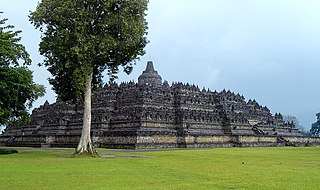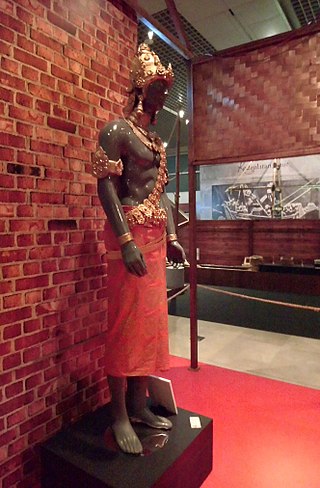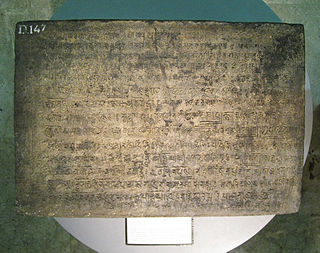Related Research Articles

The Shailendra dynasty was the name of a notable Indianised dynasty that emerged in 8th-century Java, whose reign signified a cultural renaissance in the region. The Shailendras were active promoters of Mahayana Buddhism and covered the Kedu Plain of Central Java with Buddhist monuments, one of which is the colossal stupa of Borobudur, now a UNESCO World Heritage Site.

Magelang is one of six cities in Central Java Province of Indonesia that are administratively independent of the regencies in which they lie geographically. Each of these cities is governed by a mayor rather than a bupati. Magelang city covers an area of 18.54 km2 and has a population of 118,227 at the 2010 census and 121,526 at the 2020 census; the official estimate as at mid 2022 was 121,675. It is geographically located in the middle of the Magelang Regency, between Mount Merbabu and Mount Sumbing in the south of the province, and lies 43 km north of Yogyakarta, 15 km north of Mungkid and 75 km south of Semarang, the capital of Central Java.

The Mataram Kingdom ; also known as Medang Kingdom was a Javanese Hindu–Buddhist kingdom that flourished between the 8th and 11th centuries. It was based in Central Java, and later in East Java. Established by King Sanjaya, the kingdom was ruled by the Shailendra dynasty and Ishana dynasty.

The Sanjaya dynasty was a Javanese dynasty which ruled the Mataram Kingdom in Java during the first millennium CE. The dynasty promoted Hinduism on the island.

Kedu Plain, also known as Progo River Valley, is the fertile volcanic plain that lies between the volcanoes Mount Sumbing and Mount Sundoro to the west, and Mount Merbabu and Mount Merapi to the east. It roughly corresponds to the present-day Magelang and Temanggung Regency of Central Java, Indonesia.
Sri Maharaja Rakai Layang Dyah Tulodong was a maharaja of the Mataram Kingdom of Central Java who succeeded Daksha and reigned for from 919 to either 924 or 928 AD. Historians have posited that Tulodong was the son of Balitung whose reign ended about eight years prior to the start of Tulodong's.

Samaratungga was the head of the Sailendra dynasty which ruled the Mataram Kingdom and Srivijaya in the 8th and 9th centuries. He was the successor of King Indra, and his name was mentioned in the Karangtengah inscription dated 824 CE as the constructor of a sacred Buddhist building called Venuvana to place the cremated ashes of his predecessor King Indra of Sailendra. During his administration, he initiated the construction of a massive Buddhist monument Borobudur. Samaratungga married Dewi Tara, the princess of Srivijayan ruler Dharmasetu, which created a close political alliance between the Sailendras and Srivijaya.

Sanjaya was the founder of the Mataram Kingdom during the 8th century. His name was carved in the Sanskrit Canggal inscription which was found at the Gunung Wukir temple that stood on Wukir or Ukir hill on the southern Kedu Plain in Central Java.
Dyah Pancapana or regnal name Śrī Mahārāja Dyaḥ Pañcapaṇa Kariyāna Paṇaṃkaraṇa Śrī Saṅgrāmadhanañjaya, was the second king of Mataram from the Shailendra dynasty whose kingdom was centered on the Java island Indonesia. He was the immediate successor of Sri Sanjaya, the founder of Sanjaya dynasty as mentioned in the Kalasan inscription. The name of Panangkaran is mentioned in the Balitung charter as the line of kings who were named as the 'builders of kraton'.

Balaputradewa was the maharaja of Srivijaya in the 9th century CE as well as the former head of the Sailendra dynasty. He was the youngest son of the preceding Sailendran maharaja, Samaratunga, through marriage with Dewi Tara who was in turn the daughter of another maharaja, Dharmasetu of Srivijaya.
Balitung was a Javanese king of Mataram. Balitung was his birth name, though like other Javanese kings of this period, he was commonly referred to by his appanage title Rakai Watukura. He reigned from 10 May 898 to c. 911–912. His territories included a wide range of areas in Central Java and East Java.
Rakai Pikatan was a king of the Sanjaya dynasty Mataram Kingdom in Central Java who built the Prambanan temple, dedicated to Shiva, which was completed in 856 AD. Rakai Pikatan was also called Mpu Manuku.

Pramodhawardhani was the queen consort of King Rakai Pikatan of Mataram Kingdom in 9th century Central Java. She was the daughter of Sailendran king Samaratungga.

The Canggal inscription is a Sanskrit inscription dated to 732, discovered in the Gunung Wukir temple complex in Kadiluwih village, Salam, Magelang Regency, Central Java, Indonesia. The inscription is written in the Pallava alphabet. The inscription documents an edict of Sanjaya, in which he declared himself the universal ruler of the Mataram Kingdom.

The Minto Stone or Sangguran Inscription, known in Indonesia as Prasasti Sangguran, is a 3 long tons (3.0 t), 2 metres (6.6 ft) tall epigraphy found in Malang, East Java province. In 1812, Sir Thomas Stamford Raffles, then Lieutenant-Governor of the island of Java, removed it along with the so-called "Calcutta Stone" as a token of appreciation to his superior, then British Governor-General of India, Lord Minto. It consequently became part of the Minto family estate near Hawick, Roxburghshire, Scotland.

The Kalasan inscription is an inscription dated 700 Saka, discovered in Kalasan village, Sleman Regency, Yogyakarta, Indonesia. The inscription was written in Sanskrit with Pranagari script. This is the first inscription discovered in Indonesia that mentioned the dynastic name of Sailendra as Sailendravamça.

The Shivagrha inscription is an inscription from the Mataram Kingdom of Central Java, dated in chandrasengkala (chronogram) ”Wwalung Gunung sang wiku”, that is, the year 856 CE. The inscription was inscribed by order of Dyah Lokapala right after the end of Rakai Pikatan's reign and gave a detailed description of a grand temple compound dedicated to Shiva called Shivagrha, corresponding to the Prambanan temple compound.
Kaladi inscription is a series of Javanese inscriptions engraved on copper plates dated from the year 831 Saka or 909 CE originated from the Kingdom of Mataram period. It was written in the form of prose in standard Kawi script with some variations, and using the Old Javanese language. This inscription was carved on copperplate totaling 10 plates, however two plates are missing; the plate numbers 3 and 5. Today the 8 plates of Kaladi inscriptions are stored in the National Museum of Indonesia in Jakarta with inventory number E71.

Śrī Mahārāja Rakai Kayuwangi Dyah Lokapāla Śrī Sajjanotsavatuṅga was the seventh monarch of the Mataram Kingdom of Central Java period who ruled between 855 and 885. His birthname was Lokapāla, as indicated by the title dyah or pu that precedes it. He was also commonly referred to by his appanage title Rakai Kayuwangi, which means 'Lord of Kayuwangi'. King Lokapāla was described as a valiant king who defeated his enemies.
References
- ↑ Coedès, George (1968). Walter F. Vella (ed.). The Indianized States of Southeast Asia. trans.Susan Brown Cowing. University of Hawaii Press. ISBN 978-0-8248-0368-1.
- ↑ Truman Simanjuntak (2006). Archaeology: Indonesian perspective : R.P. Soejono's festschrift. Lembaga Ilmu Pengetahuan Indonesia, International Center for Prehistoric and Austronesian Studies (Indonesia), Yayasan Obor Indonesia. p. 407. ISBN 979-26-2499-6.
- ↑ Selayang Pandang: Sejarah , Situs Resmi Pemerintah Kota Magelang, Dinas Perhubungan, Komunikasi dan Informatika Kota Magelang, © 2009. Retrieved 23 December 2010.